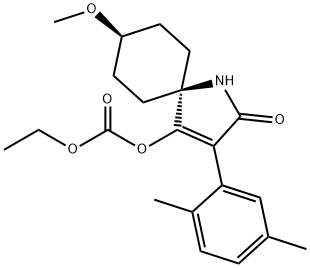Spirotetramat 螺虫乙酯
Introduction: Spirotetramat is an insecticide derived from tetramic acid, a systemic material, for the control of sucking insects in their juvenile, immature stages, including aphids, scale insects, and whitefly. It produces growth inhibition of younger insects, reduces the ability of insects to reproduce, resulting in mortality. It acts to inhibit the biosynthesis of lipids and represents a new alternative for the control of problematic insects such as Planococcus ficus and Aphis gossypii.
Common name: Spirotetramat
Another name: Movento; Ultor; (5s,8s)-3-(2,5-Dimethylphenyl)-8-methoxy-2- oxo-1-azaspiro[4.5]dec-3-en-4-yl ethyl carbonate; UNII-4G7KR034OX; etc.
Chemical name:
cis-4-(ethoxycarbonyloxy)-8-methoxy-3-(2,5-xylyl)-1-azaspiro[4.5]dec-3-en-2-one
Empirical formula: C21H27NO5
Structural formula:

Mol. Weight: 373.48 g/mol
CAS No.: 203313-25-1
Specifications
Leading Spirotetramat supplier
Spirotetramat 95% TC
Spirotetramat 22.4% SC
Packing:
BULK PACKING
Powder: 25kg/Bag, 25kg/Drum, 50kg/Drum etc.
Liquid: 200L/Drum, 20L/Drum, 10L/Drum etc.
SMALL PACKING
Powder: 1kg/Alu bag, 500g/Alu bag, 200g/Alu bag, 100g/Alu bag, 50g/Alu bag, 15g/Alu bag etc.
Liquid: 5L/Drum, 1L/Bottle, 500ml/Bottle, 250ml/Bottle, 100ml/Bottle, 50ml/Bottle etc.
Customerized packing label
Spirotetramat FAO standard
Professional registration
HAZARDS IDENTIFICATION
Hazard statement(s)
H317 (100%): May cause an allergic skin reaction.
H319 (67.14%): Causes serious eye irritation.
H335 (65.71%): May cause respiratory irritation.
H361 (65.71%): Suspected of damaging fertility or the unborn child.
H400 (65.71%): Very toxic to aquatic life.
H410 (65.71%): Very toxic to aquatic life with long lasting effects.
Precautionary statement(s)
P201: Obtain special instructions before use.
P202: Do not handle until all safety precautions have been read and understood.
P261: Avoid breathing dust/fume/gas/mist/vapors/spray.
P272: Contaminated work clothing should not be allowed out of the workplace.
P273: Avoid release to the environment.
P280: Wear protective gloves/protective clothing/eye protection/face protection.
P281: Use personal protective equipment as required.
P302+P352: IF ON SKIN: wash with plenty of water.
P304+P340: IF INHALED: Remove person to fresh air and keep comfortable for breathing.
P305+P351+P338: IF IN EYES: Rinse cautiously with water for several minutes. Remove contact lenses if present and easy to do - continue rinsing.
P308+P313: IF exposed or concerned: Get medical advice/attention.
P321: Specific treatment (see ... on this label).
P337+P313: IF eye irritation persists: Get medical advice/attention.
P363: Wash contaminated clothing before reuse.
P391: Collect spillage.
P403+P233: Store in a well-ventilated place. Keep container tightly closed.
P405: Store locked up.
P501: Dispose of contents/container to.
Supplemental Hazard Statements: none.
MAMMALIAN TOXICOLOGY
Acute toxicity: 1) Acute oral LD50 for rats is >2000 mg/kg. 2) Acute dermal LD50 for rats is >2000 mg/kg. 3) Acute inhalation toxicity LC50 (4 h) for rats is >4.18 mg/L. 4) Skin irritation: Non-irritating to skin (rabbits). 5) Eye irritation: Moderately irritating to eyes (rabbits). 6) Skin sensitization for guinea pig: Sensitizing.
NOEL: (2 y) for male rats is 12.5 mg/kg/day, for female rats is 16.8 mg/kg/day; (1 y) for dogs is 5 mg/kg/day. Other Not genotoxic.
ADI 0-0.05 mg/kg b.w.
Classification:
WHO Classification: III (Slightly hazardous)
EC Risk Classification: Reproduction risk category 2 and 3: R61, R62; Xn - Harmful: R43; Xi - Irritant: R36
US EPA Classification (formulation): No consensus across products or no products available.
ECOTOXICOLOGY
Effect on birds: Acute oral LD50 (8 d) for Mallard is >2000 mg/kg. Effect on fish: Acute LC50 (96 h) for Sheepshead minnow is 1.96 mg/l. Effects on aquatic invertebrates: Acute EC50 (48 h) for Daphnia magna is >42.7 mg/l. Effects on algae: Acute 72 hour EC50 for Pseudokirchneriella subcapitata is 0.96 mg/l. Effects on bees: Contact acute 48 hour LD50 is >100 μg/bee, oral acute 48 hour LD50 is >107.3 μg/bee. Effects on earthworms: Acute 14 day LC50 is >1000 mg/kg.
ENVIRONMENTAL FATE
Spirotetramat had a half-life of 32.5 days at pH 4 and 13.1 days at pH 7 at 20℃. In a sterile buffer solution of pH 5.0, spirotetramat degraded with a half-life of 14.4 days. In a natural water at pH 7.9, the half-life was 0.74 days. It was not possible to assess the rate of photodegradation of spirotetramat on moist soil because most degradation was due to microbial activity (which was more active under dark conditions).
Usage: Spirotetramat was developed by Bayer. It is a new insecticide for the control of a wide range of sucking insects on crops such as fruit and potatoes.
Application: Spirotetramat is highly efficient and with broad spectrum, which can effectively prevent and suck all kinds of piercing mouthparts pests, such as aphids, thrips, psylla, mealybugs, whitefly, scale insects and so on. The main crops that can be applied include cotton, soybeans, citrus, tropical fruit trees, nuts, grapes, hops, potatoes and vegetables. Studies have shown that it has good selectivity for important beneficial insects such as ladybugs, hoverflies and parasitoids.
| 






